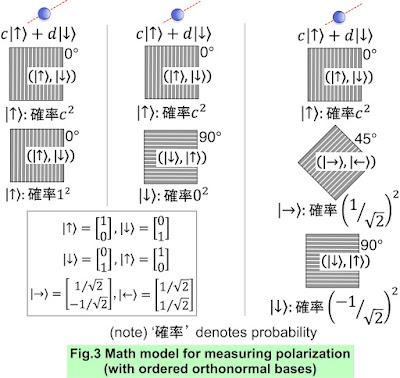I created an app in Thunkable that faithfully reproduces the photon polarization experiment. Thunkable is a no-code programming system, similar to MIT App Inventor, but it incorporates a unique concept and is mainly an application development environment for advanced users.
●Purpose of the app
The main aim of the app is to familiarize students with the fundamentals of quantum computing through photon polarization. What I am doing here is an experiment in which linear polarizers are superimposed and images are viewed. When two polarizing sheets are stacked vertically (axis angle 0°) as in Fig.1(a), it is clearly visible, but when the front sheet is tilted 90° as in Fig.1(b), it is not visible at all. However, if another polarizing sheet is inserted between these two sheets at an angle of 45° as in Fig.1(c), it can be seen to some extent. Since the polarizing sheet is a filter, it is hard to imagine that it is better to see three polarizers than two. No matter how many times I try, it still surprises me.
●App overview
The newly developed Thunkable app, as shown in Fig. 2, faithfully reproduces this mysterious phenomenon on a smartphone screen.
Also, please take a look at the video below, which shows the operation in the order of (a), (b), and (c) in Fig.2. The installation of the polarizing sheet is specified using a switch, and the angle of its axis can be changed by operating a slider.
●Mathematical model behind the app
This phenomenon can be explained by the quantum computing model shown in Fig.3. That is, it can be explained using an ordered orthonormal basis that corresponds to the orientation of the polarizer. The details are explained in the section “The Basis Associated with a Given Polarization Direction” in Reference [1].
●Important points when creating the app
When developing this app, it is necessary to find the probability p that a photon polarized at an arbitrary angle θ passes through a polarizing sheet with a tilt angle α. It can be calculated using the formula shown in Fig.4.
By reflecting this probability of passing proportionally to the transparency of the colored paint, we were able to reproduce a close-to-realistic appearance on the smartphone screen.
(Note) In this app, calculations are made assuming that the square polarizer is large enough. Therefore, when a small polarizing plate is used as shown below, the appearance of the edge portion may differ from the actual experimental results.
●Link to the app
(This app has been tested on Android, but not yet on iOS.)
Reference
[1] Chris Bernhardt: Quantum Computing for Everyone, The MIT Press, 2020.







0 件のコメント:
コメントを投稿